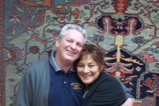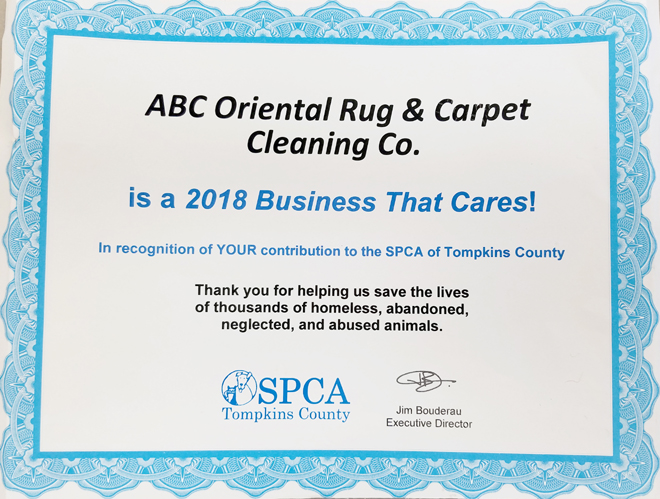ABC MONTHLY NEWSLETTER
AUGUST 2019
Welcome to Our Monthly Newsletter!
We hope you will enjoy this month's articles.
This month's topics are:
AREA & ORIENTAL RUGS
MISCELLANEOUS
AUGUST SPECIALS
If there is a topic you would like us to cover in one of our upcoming newsletters, please call us at
607-272-1566
or contact us by clicking here.
GREAT NEWS!
GOT QUESTIONS?
NOW YOU CAN TEXT US at
607-272-1566
AUGUST 2019
Cleaning Special...
AUGUST IS OFTEN OUR
HOTTEST
and
MOST HUMID
SUMMER MONTH
IF YOU HAVE PETS and
YOU HAVE AREA RUGS
YOU KNOW WHAT THIS CAN MEAN...
SMELLY RUGS!

NO PROBLEM!
We can get those odors out!
Our August Special is:
30% OFF Odor Removal from Area and Oriental rugs**
**Yes. We can remove the odor (especially urine) from most oriental and area rugs.
Guaranteed!
For FREE PICKUP & DELIVERY
please call 607-272-1566
to schedule an appointment.
or
Bring in your rugs to our cleaning plant at 130 Cecil Malone Drive Ithaca
HEREKE ORIENTAL RUGS
LOCATION & HISTORY
LOCATION
Hereke oriental rugs originated in the coastal town of Hereke, almost 200 years ago, on the north shore of Izmit bay in northwest Turkey. Hereke is approximately 40 miles southeast of Istanbul.
HISTORY
The Ottoman Empire
Turkey was an integral part of the Ottoman Empire for centuries. At its height, the Empire included the area from Hungary in the north to Somalia in the south and from Algeria in the west to Iran in the east.
The
sultans of the Ottoman Empire were all members of the House of Osman
and ruled over the transcontinental empire with an iron hand from its
inception in 1299 to its dissolution in 1922. The city of Bursa in
Anatolia was the first capital. In 1366, the capital was moved to
Edirne and in 1453 the capital was moved to Constantinople (now known
as Istanbul).
Sultan Abdulmecid I in 1841
The Ottoman sultan, Abdulmecid I played an essential role in the establishment of the town of Hereke and the weaving of Hereke oriental rugs. He founded the Hereke Imperial Manufacture in 1841 with the sole purpose of furnishing his palace, Dolmabahce, built from 1843 to 1856. The best artists and rug weavers were called from the cities of Sivas, Ladik, and Manisa to Hereke to produce the highest quality rugs, fabric, upholstery, and curtains for the palace.
1843
In 1843, a rug making school was established in Hereke, where both Muslim and Christian women and children attended classes. In 1878, the factory burned to the ground but was rebuilt in 1882. Today this factory continues to operate as a museum-factory.
In
the years following the construction of Sultan Abdulmecid I's
palace, Hereke rugs were woven only to furnish other royal residences or
given as gifts to visiting royals from countries such as Japan,
Russia, Germany, and England.
1890
It wasn't until 1890 that a number of traders in Istanbul were allowed to sell some of the rugs woven in Hereke.
1922
With the end of the Ottoman Empire in 1922, the production of Hereke rugs was restricted until the middle of the 20th century when some master weavers in Hereke once again began weaving Hereke oriental rugs, continuing the tradition of the Ottoman palace rugs.
Today
Today, Hereke rugs are still made with the traditional patterns of Sultan, Abdulmecid I, as well as both traditional Anatolian and contemporary figurative patterns.
Unfortunately, the actual town of Hereke no longer technically exists since it lost its municipality status in 2008 due to an insufficient population.
CONSTRUCETION OF HEREKE ORIENTAL RUGS
Unique Construction Method
The construction method used to create Hereke oriental rugs is unique.
Rather than placing the warps (up and down cords) next to one another as in most other construction techniques, two sets of warps are used. The first set of warps is located in front of the second set. This allows for the use of a second weft (side to side thread which interlaces through the warps). This weft is thinner and zig-zags to securely hold the knots in place should the rug be damaged.
The knots are then tied a second time using the Turkish or Ghiordes symmetrical knot. This makes for an extremely durable rug with well-defined patterns.
Materials Used
The materials used to make Hereke oriental rugs include silk, a combination of wool and cotton, and sometimes gold or silver thread is also used. These rugs can be found made with wool or camel hair or silk on a cotton foundation as well as silk on silk.
A genuine, pure silk Hereke oriental rug always uses silk from the city of Bursa in Turkey. Bursa has for centuries produced the highest quality of silk. Bursa was a station on the famed Silk Road and a world trade center of silk cocoons and silk fabric.
When
wool is used for these rugs, only the finest wool, known as cork wool, is
used. This wool comes from the neck of the sheep and has a high content
of wool grease (lanolin), making it soft and easy to work with.
Hereke Rug Sizes
The rugs are generally very large, although the silk on silk rugs are made in smaller sizes. Some silk Hereke rugs have from 3000 to 4000 knots per square inch. Those made of wool are typically in the 1200 knots per square inch range.
The weaving of all
fine Hereke rugs, especially the silk on silk ones, is very labor
intensive and even the small rugs can take more than a year to complete.
Design of Hereke Oriental Rugs
Because of their construction, the Hereke rugs have more curvilinear designs and show more Persian influenced patterns than most other Turkish rugs.
The silk Herekes typically come in soft pastels with intricate floral motifs such as the carnation, tulip, rose, crocus, lilac, hyacinth, and plum blossom. Quarter medallions are often found in the corners.
Some Common Motifs Used in Hereke Oriental Rugs
Please continue reading here for more information and photos of Hereke Oriental Rugs.
BUYING RUGS IN TURKEY
Buying rugs in Turkey? Who takes a trip to Turkey without at least being tempted to buy a genuine handmade Turkish rug to take home with them?
To avoid being outwitted by a seasoned Turkish rug seller with the possibility of being talked into an overpriced 'bargain,' it would be to your advantage to gain some know how before buying rugs in Turkey (or in the United States as well).
EXPECT THE TRADITIONAL SALES DEMONSTRATION BEFORE BUYING RUGS IN TURKEY
Wherever your tour of Turkey takes you, but especially in cities like Istanbul, you will find yourself being warmly greeted by a veteran rug salesman and invited to view a 'traditional rug sales demonstration' meant to give you the information you need for buying rugs in Turkey. You will be made comfortable and offered complimentary beverages such as chai and Turkish coffee.
Be prepared for a thorough history of Turkish rugs, as well as the fact they are one-of-a-kind and will last for years and years. They can become family heirlooms, passed down from generation to generation. They are hand-made with a special construction making them very durable and the dyes are all natural. You will also learn all about Turkish rugs made of silk and how the silk is produced. You will be told the number of threads per inch or centimeter and the fiber content of a Turkish rug are the most important factors in a rug's value and the cost to you. All of that is true but may be a bit overwhelming all at once.
If you enjoyed the beginning of the demonstration, you may actually be almost ready for buying rugs in Turkey. You will be asked by the salesman what type of Turkish rug you are interested in buying such as the size, colors, and style. Then you will be impressed by the seeming never-ending supply of rugs that will be laid at your feet by his assistants. Your salesman is dedicated to keeping those rugs coming until you fold!
In order to feel confident about the rug or rugs you have fallen in love with and may be ready to buy, you must make sure you have found a reputable dealer. If you are in Istanbul, the Istanbul Handicraft Center would be a good place to go. Here you will find not only knotted Turkish rugs but woven kilims or flatwoven rugs as well. The Istanbul Handicraft Center may be able to help you with buying rugs in Turkey by suggesting reputable dealers in other areas, too.
WHERE DO THE RUGS COME FROM?
Rug weaving is a traditional craft in Turkey and is taught by mothers to their daughters in each generation. The daughters will need to learn to weave so they can prepare to produce items for their dowry and trousseau. Today, Board of Education schools have been sponsored by the Turkish government so young girls can enroll in a weaving course to better their skills
You may find there is more often than not a sales company set up and attached to these schools so rugs can be bought directly from where they were made. Used Turkish rugs will also be available for sale.
Although there is no guarantee a rug will increase in value, it is entirely possible a durable, hand-made Turkish rug in good condition may very well do just that. At any rate, it is unlikely you will regret buying rugs in Turkey.
THE PRICE
Please continue reading here to learn how to 'haggle' price and more about buying rugs in Turkey.
MINIMALISM
WHAT IS MINIMALISM?
Minimalism is the art of letting go of things that interfere with how we wish to spend our time.
Letting go of those things that do not add value to our lives can allow us to create the space and time we need in order to lead simpler, more meaningful lives.
THE ACCUMULATION OF MATERIAL THINGS
When we are young, we may start out having a pretty good idea of how we want to spend our time, such as pursuing a career or raising a family or building a business. We start collecting material things as soon as we start accumulating money and before we know it, we have accumulated more material wealth than we have the space for. We may need a larger home or a more demanding job just to maintain it all.
We have developed hobbies, bought toys for our children and, let's face it, toys for ourselves. We hold on to things we may need later, broken things we may fix later, and so on through the years. This continuing accumulation of material wealth can go on for 40 years or more and result in a wearisome overabundance of seemingly endless clutter!
WHEN WE ARE OLDER
When we are in our 60s and 70s, we may want to (or have to) downsize for whatever reason. We look back on all those 'things' we have collected and the panic of what to do with all of them sets in! What to keep, what to donate, what to give to children or other relatives or friends, what to throw away. Minimalism may be the answer to freeing ourselves from the exhaustion and stress of taking care of all those 'things.'
There is an actual cost to the accumulation of things, according to Henry David Thoreau who wrote, "The price of anything is the amount of life you exchange for it." As soon as you embrace minimalism, you will find the 'cost' of what you have accumulated is very much overpriced.
PRACTICING THE ART OF MINIMALISM CAN LEAD TO FINDING THE REAL MEANING OF LIFE!
Beginning the practice of the art of minimalism is a daunting task and it is not for the weak hearted! But once begun, it is a process that gets easier as time goes on.
Time
is the reason why minimalism works. Time to develop closer
relationships with family, time to renew old friendships, and time to
develop new relationships. Time to spend doing activities or whatever
makes us happy. That is the real meaning of life.
ARE YOU READY TO LET GO?
If letting go and living minimally appeals to you, we have a few suggestions for how to begin and they are listed below.
Minimalism is a process, and depending on where you are in your life, it could take a long while to accomplish. After all, it may have taken 40 or more years to accumulate the clutter of material things, so getting rid of all that clutter cannot be accomplished in a few days or maybe even a few years.
Keep in mind though, our lives will never have zero clutter or complications because we are human and part of the real world, living with the other people in it. But when we focus on what really matters to us, we can learn to let go of what does not. If you own too much stuff, your life will be owned by your stuff. If you keep more than you need, you will be giving less to others in need.
Beware! If you think you are okay because you are able to organize all your possessions, you may really be practicing 'successful hoarding' and simply pushing away the day when you may need, or be forced, to pare down your belongings.
THE BENEFITS OF MINIMALISM
Please continue reading here for the benefits of minimalism, where to start, general guidelines, and more.
THANK YOU!! WE LOOK FORWARD TO CONTINUING TO SERVE YOUR TEXTILE CLEANING AND REPAIR NEEDS!
Get New Posts Right To Your Inbox!
Get our monthly newsletter, just like this one, delivered right to your inbox each day. Just sign up and we will send you the best new articles and videos as they become available.
Your email address will NEVER be spammed, sold, or shared. You are welcome to unsubscribe at any time with the link in the email.
"The Cleanest Clean You've Ever Seen."
by
ABC Oriental Rug & Carpet Cleaning Co.
130 Cecil Malone Drive Ithaca, NY 14850
607-272-1566

ABC
Carpet & Rug
Spotting Guide

ABC Oriental Rug & Carpet Cleaning Co. has been family-owned and operated in Ithaca and surrounding areas for more than 48 years.
Our company is a reflection of our family name and pride.
Please Like us on Facebook!
for more information and to find out what we are doing at our business and in the community!
Stay Connected!
Links to Our Services
Allergy Cleaning
Area Rug Cleaning
Oriental Rug Cleaning
Rug Hand & Machine Repair
Upholstered Furniture Cleaning
Tile & Grout Cleaning & Sealing
We are proud sponsors of the SPCA of Tompkins CO:

Newsletter Archives

